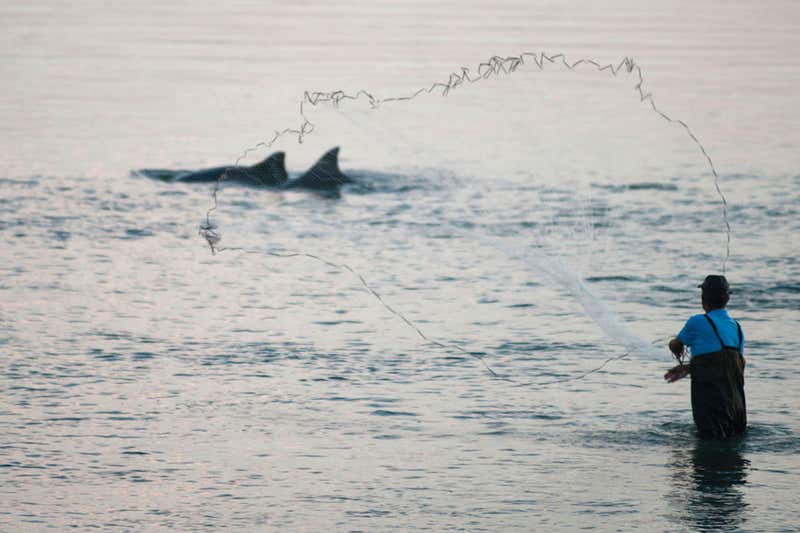By: Alexa Kownacki, Ph.D. Student, OSU Department of Fisheries and Wildlife, Geospatial Ecology of Marine Megafauna Lab
Human-wildlife interactions have occurred since people first inhabited the Earth. However, today, when describing human-wildlife interactions specifically in relation to dolphins, frequently we hear about ‘conflicts’. Interactions between fisheries and dolphins that lead to bycatch or depredation (stealing bait/catching from gear) are particularly common. But, symbiotic relationships with dolphin species and certain human groups can also be mutualistic, with both groups benefitting. These symbiotic relationships have been around for hundreds, if not thousands of years.

In eastern Australia, cooperative fishing interactions occur between Aboriginal Australians and dolphins—both bottlenose dolphins and orcas. In Burleigh Heads National Park, Queensland, AUS, the dolphins are thought to help the local indigenous Kombemerri (saltwater) people hunt for fish. Indigenous stories recall men wading into the water with their spears and nets. Then, many of the men would hit the surface waters to make noises with the splashes. Underwater, this sound was amplified and then the dolphins would begin chasing the fish toward the men and their nets (Neil 2002). Aboriginal Australians, especially those in eastern Australia have an emotional and spiritual connection to both dolphins and orcas. There are widespread accounts of cooperation between indigenous people and small cetaceans on the eastern Australian coastline, which create both context and precedent for the economic and emotional objectives to contemporary human-dolphin interactions such as dolphin provisioning (Neil 2002).

In the coasts off of Laguna, Brazil, bottlenose dolphins and local fishermen cooperatively fish while tourists gather to watch. Previously, PhD candidate Leila Lemos wrote about these interactions in a blog post. Like many groups of socializing dolphins, these dolphins have a unique whistle to recognize each other. The waters surrounding Laguna, Brazil are murky, turbid and dark green to the point where the fisherman cannot see any of the fish in the water. As the fishermen wade into the murky waters, bottlenose dolphins chase shoals of mullet toward the shore. Then the dolphins tail slap or abruptly dive, “signaling” the fishermen to cast their nets. Research has shown that when the fishermen “work with” the dolphins, both the dolphins and the people catch more, larger fish (Roman 2013). One fisherman claims it is not worth fishing unless the dolphins are around (Roman 2013). Here, the fishermen know the dolphins based on their markings. They know which dolphins participate in the different parts of hunting as well—which dolphin initiates the tail slap, which dolphin usually circles the fish, and which drive the fish towards the coastline. After the dolphins round up and chase the fish for the fishermen and themselves, there is no “reward” from the fishermen for the dolphins—no fish tossed their way. Scientists also found there is a difference in whistle structure between cooperative and non-cooperative dolphin groups (Preston 2017).

Along most coastlines worldwide, humans and dolphins are competitors. Dolphins are seen as thieves who steal fish out of nets, or get caught in their gear and ruin fishing opportunities. Thus, dolphins are often unwelcome near fishing communities. Such negative interactions sometimes lead to human-caused fatalities of dolphin from gunshots or stabbings, thought to be from angry fishermen. Yet, in this same world, fishermen thank the dolphins for bringing their catch to them. Clearly, both humans and dolphins share high intelligence levels and skills in fishing. If it is a matter of two minds are better than one, then I think indigenous communities figured this equation out first: working with the dolphins, and not against, can better feed their people.
Citations:
Neil, David. (2002). Cooperative fishing interactions between Aboriginal Australians and dolphins in eastern Australia. Anthrozoos: A Multidisciplinary Journal of The Interactions of People & Animals. 15. 10.2752/089279302786992694.
Preston, Elizabeth. “Dolphins That Work with Humans to Catch Fish Have Unique Accent.” New Scientist, 2 Oct. 2017, www.newscientist.com/article/2149139-dolphins-that-work-with-humans-to-catch-fish-have-unique-accent/.
Roman, Joe. “Fishing with Dolphins: An astonishing cooperative venture in which every species wins but the fish.” Slate Magazine, 31 Jan. 2013, slate.com/technology/2013/01/fishing-with-dolphins-symbiosis-between-humans-and-marine-mammals-to-catch-more-fish.html.